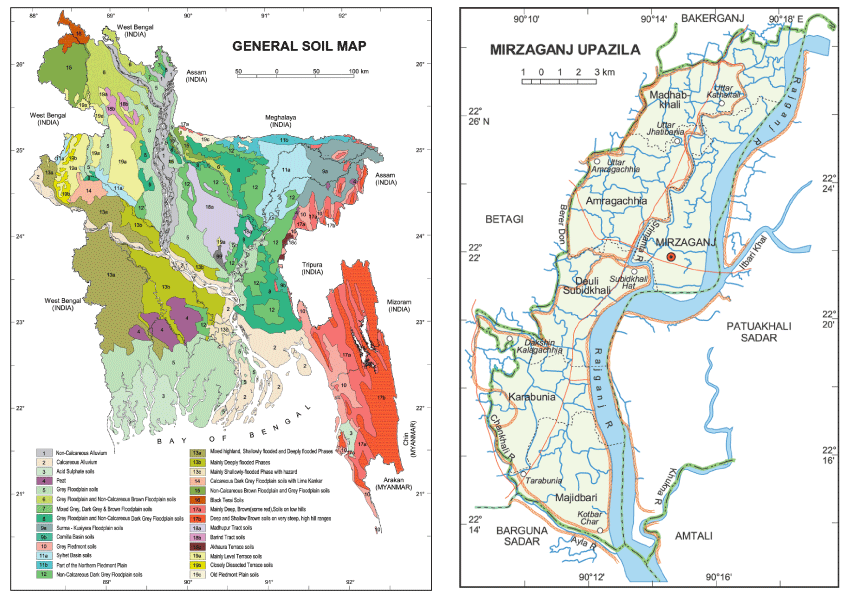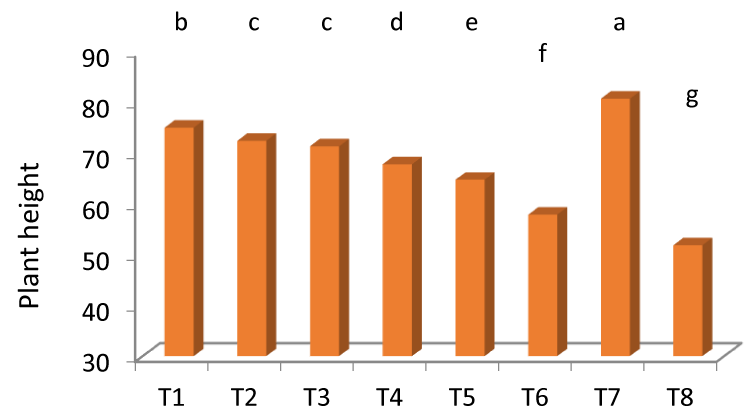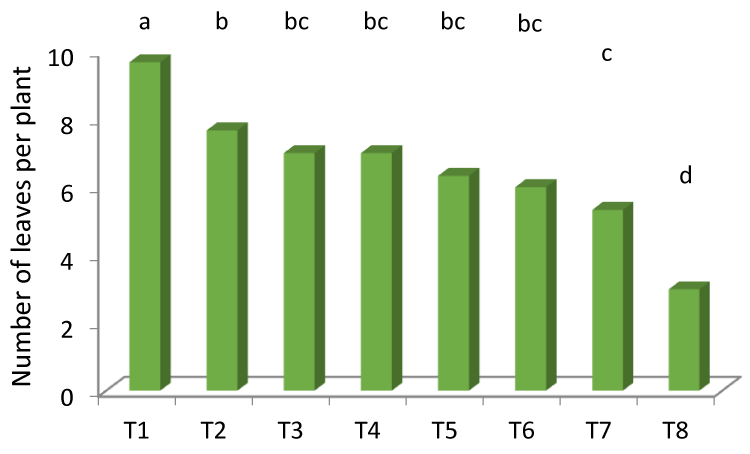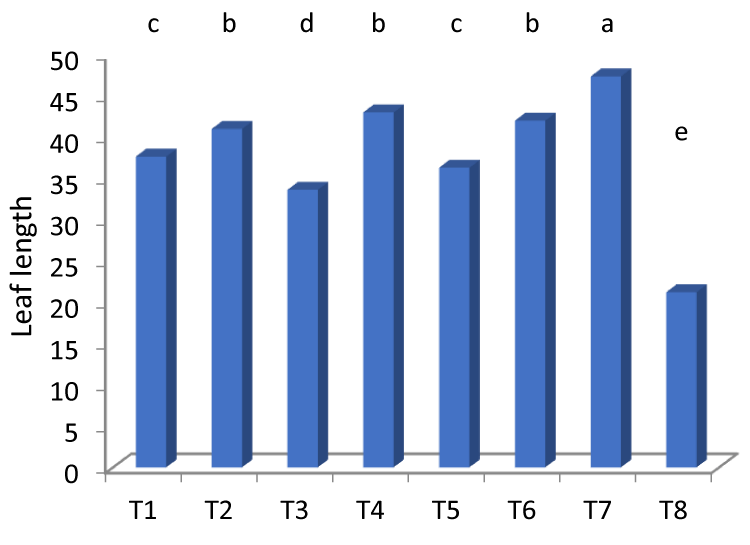Open J Biol Sci
Effect of Green Manure Along With Nitrogenous Fertilizer on the Growth and Yield of Turmeric (Curcuma Longa L.) of Bangladesh
Mahbuba Ferdous1, Mohammad Kabirul Islam1, Md Monirul Islam1*, Md Isfatuzzaman Bhuyan2, Md Sazedul Islam1 and Dabasish Mondal1
2Department of Agronomy, Bangladesh Agricultural University, Mymensingh, Dhaka, Bangladesh
3Department of Agronomy, Patuakhali Science and Technology University, Dumki, Patuakhali, Dhaka, Bangladesh
Cite this as
Ferdous M, Islam MK, Monirul Islam Md, Isfatuzzaman Bhuyan Md, Sazedul Islam Md, et al. (2018) Effect of Green Manure Along With Nitrogenous Fertilizer on the Growth and Yield of Turmeric (Curcuma Longa L.) of Bangladesh. Peertechz J Biol Res Dev 3(1): 001-005. DOI: 10.17352/ojbs.000011Turmeric is an important spice crop of Bangladesh. A field experiment was conducted at farmer’s field of North Jhatibunia, Mirzagonj, Patuakhali during April, 2015 to February, 2016. The study was performed to find out the effect of green manure and nitrogenous fertilizer on the growth and yield of turmeric (BARI Halud-2), in coastal region of Bangladesh. In this study different combinations of green manure along with nitrogenous fertilizer were used. There was eight treatment combinations (viz. 7 ton biomass/ha + 100 kg N/ha, 7 ton biomass/ha + 80 kg N/ha, 7 ton biomass/ha + 60 kg N/ha, 7 ton biomass/ha + 40 kg N/ha, 7 ton biomass/ha + 20 kg N/ha, 7 ton biomass/ha, 100 kg N/ha and control). The highest number of leaves per plant (11.67) were recorded by the combined application of 7 ton biomass/ha along with 100 kg N/ha. The highest plant height (80.70 cm) and the longest leaf length (47.33 cm) were recorded by the application of 100 kg N/ha. The highest number of tillers per plant (7.67), maximum number of primary rhizomes per plant (9.00), maximum fresh weight of clump (189.67 g), highest fresh weight of roots (48.01 g), maximum fresh weight of rhizomes (277.70 g), maximum dry weight of clump (20.01 g), highest dry weight of roots (9.25 g), maximum dry weight of rhizomes (67.50 g) and maximum yield of fresh rhizome per hectare (6.64 tons) were recorded by the combined application of 7 ton /ha biomass+ 40 kg N/ha. Highest number of secondary rhizomes per plant (17.00) and maximum number of tertiary rhizomes per plant (7.00) were recorded by the application of 7 ton biomass/ha + 60 kg N/ha. With a few exception, the best performance in terms of growth and yield of turmeric were found from the combination of 7 ton biomass /ha + 40 kg N/ha.
Introduction
Turmeric (Curcuma longa) is an important and common spice crop of Bangladesh. Many of the country consider curry to be incomplete without it. It is widely used as a spice in South Asian and Middle Eastern cooking for its natural food coloring capacity. Among the spices crops turmeric is a popular and is used in huge numbers of food items [1]. The spice is produced by boiling the rhizome, drying them to obtain the characteristic yellow color and grinding them into powder. It is also used in preparing cosmetics and is a raw material of dyeing industries. The turmeric powder obtained from rhizome contain curcuminoids have medicinal properties which is used in the treatment of circulatory problems, liver diseases and blood purification [2]. It also show antibacterial, anti-fungal, anti-ulcer and anti-cancer effect. Now it is an important herbal medicine in the world. It has strong associations with the socio-cultural and religious life of the people of the Indian subcontinent.
Turmeric is a rhizomatous herbaceous perennial plant of the ginger family, Zingiberaceae. It is native to tropical south East Asia and needs temperatures between 20°C and 30°C with annual rainfall 1500 mm or more. This plant grows up to 1m with a short stem tufted leaf. Its flowers are yellow, between 10-15 cm in length and they group together in dense spikes, which appear from the end of spring until the middle session. It is ready for harvesting 7 to 10 months after planting, when the lower leaves turn yellow. The whole turmeric rhizome, with a rough, segmented skin. The rhizome is yellowish-brown with a dull orange interior that looks bright yellow when powdered. Rhizome measures 2.5-7.0 cm (in length), and 2.5 cm (in diameter) with small tuber branching off [3]. It contains appreciable quantities of proteins (6.3%), lipids (5.1%), carbohydrates (69.4%) and fibre (2.6%). Turmeric is rich in minerals like phosphorus, calcium, iron and vitamin A [4].
It can be grown on different types of soils, it thrives best in well-drained, fertile, sandy and black, red or alluvial loams, rich in humus and uniform in texture with a pH range of 4.5-7.5. Rich loamy soils having natural drainage and irrigation facilities are the best. Turmeric cannot stand water stagnation or alkalinity. Turmeric is propagated vegetatively through rhizome. Setts (small rhizomes 5-7 gm) with one or two buds are used for planting and well developed healthy and disease free rhizomes are to be selected. The rhizomes should be planted 7.5-8 cm deep [5]. Approximately 2500 kg of sets are required to one hectare [6]. Turmeric grows well in Nilphamari, Dinajpur, Rangpur, Khulna, Tangail, Mymensingh, Rangamati, Bandarban and Khagrachari districts of Bangladesh. In fact, India still enjoys the unique position of being the largest producer and exporter of turmeric in the world. In Bangladesh turmeric has been cultivated in an area of 60 thousand acres with the production is 149.6 thousand M. Tons and the yield is 2.5 M. Tons/acre in 2011-2012 [7].
Materials and Methods
An experiment was conducted at farmers field of North Jhatibunia of Mirzagonj, in the district of Patuakhali during the period from April, 2015 to February, 2016 to investigate on the growth and yield of turmeric (BARI Halud-2), that are suitable to cultivate in coastal region of Bangladesh with three replications under different levels of green manure along with chemical fertilizers. The details of the materials and
Methods in the present experiment are described under the following headings and sub-headings.
Description of the experimental site
Location of experimental site: Geographically, the research farm area is covered by Gangetic Tidal Flood plains within the Agro ecological Zone “AEZ- 13”. This region occupies a vast area of tidal floodplain land in the south-west part of Patuakhali district. Total coverage of this region is 17066 km2 with a total land volume of 1706600 ha (when Barisal, Jhalakathi, Pirojpur, Patuakhali, and Barguna are included) where the southern coastal zone surrounded by the Sundarbans (mangrove forest) (Map).
Soil of the experimental plot: Soil characteristics of the Research Farm were silty loams or alluvium. However, the soil of the experimental field was silly clay loam having pH value of 5.69. The characteristics of experimental soil have been presented in table 1. The organic matter content found 1.45% in most cases. Deficiency of nitrogen is acute and widespread. Status of exchangeable potassium is almost satisfactory.
Climate: Generally, Patuakhali region falls under the sub-tropical climate, which is characterized by high temperature and humidity, heavy rainfall with occasional gusty winds in the month of April to September and less rainfall associated with moderately low temperature during October to March.
Description of the experimental materials
Collection of planting materials: The setts (small rhizome) of BARI Halud-2 were collected from Breeding Division of BARI, Gazipur. The seeds were healthy, pure, well mature and free from mixture of the other seeds, weed seeds and extraneous materials.
Treatments of the experiment: The treatment includes different combinations of green manure along with nitrogenous fertilizers (the rate of fertilizers were at kg/ha) used in the experiment as follows:
i. T1= 7 ton /ha biomass+ 100 kg N/ha
ii. T2= 7 ton /ha biomass + 80 kg N/ha
iii. T3= 7 ton /ha biomass + 60 kg N/ha
iv. T4= 7 ton /ha biomass + 40 kg N/ha
v. T5= 7 ton /ha biomass + 20 kg N/ha
vi. T6= 7 ton /ha biomass
vii. T7= 100 kg N/ha
viii. T8= Control
Experimental design and layout: The experiment was laid out in a Randomized Complete Block Design (RCBD) with eight treatments where each treatment consisted of three replications.
Green manure and fertilizers: Total amounts of green manure, phosphorus (P) and potassium (K) fertilizers were applied in the whole plots as basal dose during final land preparation. Nitrogen (N) was applied in three splits, half of N dose was applied at 50 days after planting. Remaining N were applied in two equal splits at 90 and 120 days after planting. The source of N, P and K was
Urea, triple super phosphate and muriate of potash, respectively.
Treatments of rhizome: Before planting, turmeric seeds (rhizome) were treated with Vita vex-200 @ 0.25% to prevent seeds from the attack of soil borne diseases.
Placement of seed rhizome: The rhizomes of turmeric were placed on 25 April 2015. Rhizomes (25±2 g each) were placed in rows by hand plough. Matured rhizome was placed in each hill at 7.5-8.0 cm depth from the soil surface.
Soil pH: The glass electrode pH meter was used to determine the pH of the soil samples. The ratio of soil and water in the solution was 1:2.5.
EC: To determine EC of soil at first 5g soil was taken in a 100 ml beaker and then 50 ml distilled water was added to it. It was shaken for 30 minutes and then the beaker was kept for 30 minutes for precipitation. Finally suspension was collected and measured EC by EC meter.
Total Nitrogen (%): Total Nitrogen of soil samples were determined by micro Kjeldahl method. The procedure was -digestion of soil sample by con. H2SO4, 30% H2O2 and catalyst mixture (K2SO4: CuS04. 5 H20: Se=10: l: l) followed by distillation with 40%NaOH and by titration of the distillate trapped in H3BO3 with 0.01 N H2SO4 (Black 1965).
Available phosphorus: Available phosphorus content was extracted from soil with 0.5 M NaHCO3 solution at pH 8.5. The phosphorus in the extract was then determined by developing blue color with SnCl2 reduction of phosphomolybdate complex and measuring the color by spectrophotometer at 660 nm wavelength (Page et al. 1982).
Available Sulphur
Available Sulphur of soil content was determined by extracting soil sample with CaCl2 (0.15%) solution as described by Page et al. The Sulphur content in the extract was deteraiined turbid metrically and the turbid was measured by spectrophotometer at 420 nm wavelength.
Available Potassium: At first 5 g soil was taken in a conical flask and 25 ml ammonium acetate was added to it. The solution was placed to centrifuge tube and shaken for 10 minutes. Then it was centrifuged and filtered. Finally reading was observed by using flame photometer.
Results and Discussion
The results of the study have been presented under the following headings and sub-headings.
Plant height
Different combination of green manure and nitrogenous fertilizer had significant effect on plant height. Plant height was influenced by different combination of green manure and nitrogenous fertilizer .Maximum plant height (80.70 cm) was observed from 100 kg N/ha (T7) while control treatment (T8) produced minimum plant height (51.85 cm). All the other treatments showed an intermediate behavior compared to the maximum and minimum plant height. Nitrogen fertilizer ensured favorable condition for the growth of turmeric with optimum cell division and elongation of cell results was the tallest plant. Findings were comparable to the results of Akamine et al. and May et al. [8,9]. This might be due to protein synthesis by the help of nitrogen which enhance vegetative growth of turmeric plant (Figure 1).
Number of leaves per plant
Significant variability was found among different levels of green manure and nitrogenous fertilizer in case of number of leaves per plant. Number of leaves was influenced by different combination of green manure and nitrogenous fertilizer (Figure 2). The maximum number of leaves per plant (11.67) was calculated from the combination of 7 ton /ha biomass+ 100 kg N/ha (T1). In contrast, the minimum number of leaves per plant (5.33) was recorded from the control treatment. Okawara et al. [10], reported that green manure plants increase the number of leaves, plant height, and dry weight of rhizome and yield of rhizome. Akamine et al. [8], conducted a glasshouse experiment on turmeric and reported that N increases both growth and yield.
Leaf length
Different combination of green manure and nitrogenous fertilizer had significant effect on leaf length. Leaf length was influenced by different combination of green manure and nitrogenous fertilizer (Figure 3). Longest leaf length (47.33 cm) was found from 100 kg N/ha while control treatment (T8) produced shortest leaf length (21.33 cm). All the other treatments showed an intermediate behavior compared to the longest and shortest leaf length. Nitrogen fertilizer ensured favorable condition for the growth of turmeric with optimum cell division and elongation of cell and the ultimate results was the longest leaf. Medda and Hore [11], found that in combination of N and P 200 kg per ha produce the longest leaf length (46.63 cm) of turmeric plant [12].
Number of tillers per plant
Significant variability was found among different levels of green manure and nitrogenous fertilizer in case of number of tillers per plant. Number of tillers was influenced by different combination of green manure and nitrogenous fertilizer (Table 2). The maximum number of tillers per plant (7.67) was calculated from the combination of 7 ton /ha biomass + 40 kg N/ha (T4) followed by second highest number of tillers (6.85) per plant from the combination of 7 ton /ha biomass + 80 kg N/ha (T2) those are statistically similar. In contrast, the minimum number of tillers per plant (2.00) was recorded from the control treatment (T8). All the other treatments showed an intermediate behavior compared to the highest and lowest number of tillers per plant. This might be the number of tillers per plant was varied with the number of eyes on the seed rhizome. Findings regarding to the number of tillers per plant was agreed to the results of May et al. [9], (Tables 3,4).
Conclusions
A field experiment was conducted at farmers field of North Jhatibunia, Mirzagonj, Patuakhali to investigate the growth and yield of turmeric (BARI Halud-2), that are suitable to cultivate in coastal region of Bangladesh. The experimental plot was fertilized as per treatment of T1 (7 ton /ha biomass+ 100 kg N/ha), T2 (7 ton /ha biomass + 80 kg N/ha), T3 (7 ton /ha biomass + 60 kg N/ha), T4 (7 ton /ha biomass + 40 kg N/ha), T5 (7 ton /ha biomass + 20 kg N/ha), T6 (7 ton /ha biomass), T7 (100 kg N/ha) and T8 (Control) with green manure and nitrogenous fertilizer. Data were collected on growth, yield and yield contributing characters. The experiment was laid out in the Randomized Complete Block Design with three replications. Data on different parameters under this investigation were statistically analyzed with 3 replications and the means were compared with Duncan’s Multiple Range Test at 5% level of probability.
- Rahman MA, Zaman MS, Monim MA, Islam ABMS, Sultana N (2010) Effect of fertilizers in combination with organic manure on the yield performance of turmeric. J Agrofor. Environ 4: 155-158. Link: https://goo.gl/CK6uJQ
- Ishimine Y, Hossain MA, Ishimine Y, Murayama S (2003) Optimal planting depth for (Curcuma longa L.) cultivation in Dark red soil in Okinawa Island, Southern Japan. Plant Production Science 6: 83-89. Link: https://goo.gl/pUeY7a
- Jajji Lal (2012) Turmeric, Curcumin and Our Life: A Review. Bull. Environ. Pharmacol. Life Sci 1: 11 – 17. Link: https://goo.gl/n4j9iN
- Olejede AO, Iluebbey P, Dixon AGO (2005) IITA/NRCRI Collaborative Germplasm and Data Collection on root and tuber crops in Nigeria. NRCRI Annual Report 77-81.
- Srivastava A (2015) Effect of Some Manure on Quality of Curcuma. Indian Journal of Applied Research 5.
- (2015) ICAR- Indian Institute of Spices Research, Kozhikode - 673 012, Kerala. Link: https://goo.gl/MRTxgs
- BBS (2013) Report on The Productivity Survey of Turmeric Crop. Link: https://goo.gl/u75tjY
- Akamine H, Hossain A, Ishimine Y, Yogi K, Hokama K, et al. (2007) Effects of application of N, P and K alone or in combination on growth, yield and curcumin content of turmeric (Curcuma longa L.). Plant Production Sci 10: 151-154. Link: https://goo.gl/d1i3as
- May A, Cecilio FAB, Cavarianni RL, Barbosa JC (2005) Turmeric (Curcuma longa L.) development and productivity in function at nitrogen and potassium doses. Revista Brasileira de Plantas Medicinais 7: 72- 78. Link: https://goo.gl/J7oVkk
- Okawara K, Hossain MA, Akamine H,Tamaki M (2010) Effects of Green Manure on Growth, Yield and Quality of Turmeric (Curcuma longa L.) Cultivated in Dark-red Soil in Okinawa. Link: https://goo.gl/fakiHU
- Medda PS, Hore JK (2003) Effects of N and K on the growth and yield of turmeric in alluvial plains of West Bengal. Indian J of Hort 60: 84-88. Link: https://goo.gl/KLHWn4
- Swain SC, Rath S, Ray DP (2006) Effect of NPK levels and mulching on yield of turmeric in rainfed uplands. J Agril Res 18: 247-250.
Article Alerts
Subscribe to our articles alerts and stay tuned.
 This work is licensed under a Creative Commons Attribution 4.0 International License.
This work is licensed under a Creative Commons Attribution 4.0 International License.





 Save to Mendeley
Save to Mendeley
